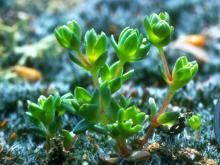Wildflowers, Grasses and Other Nonwoody Plants
Media

Species Types
Scientific Name
Microstegium vimineum
Description
Japanese stiltgrass is an invasive annual grass with thin, pale green, lance-shaped leaves that are 3 inches long. It has spread to nearly every eastern U.S. state. It forms dense patches, displacing and outcompeting native species for nutrients and light.
Media
Species Types
Scientific Name
Vernonia baldwinii
Description
Ironweeds are tough, grayish-green, branching plants known for their fluffy-looking clusters of reddish-purple florets. They are a familiar sight on roadsides and pastures. Identify western ironweed by the bracts at the base of the flowerheads.
Media

Species Types
Scientific Name
Maianthemum racemosum (formerly Smilacena racemosa)
Description
False Solomon's seal can be distinguished from "true" Solomon's seal by differences in flower shape and placement, the color of the berries, and some characteristics of the leaves.
Media

Species Types
Scientific Name
Alliaria petiolata
Description
Because each plant disperses a large number of seeds, garlic mustard can outcompete native vegetation for light, moisture, nutrients, soil, and space as it quickly colonizes an area.
Media

Species Types
Scientific Name
Hydrastis canadensis
Description
Large, crinkled, palmately 5-lobed leaves distinguish golden seal, which occurs in moist woods in the Ozarks and Central Missouri. Populations have been declining due to root diggers.
Media

Species Types
Scientific Name
Echinacea simulata
Description
One of Missouri’s five types of echinaceas, glade coneflower is distinguished by its yellow pollen, drooping pink or purple ray flowers, and narrow, tapering leaves. Look for it in the eastern Ozarks, and at native plant nurseries!
Media

Species Types
Scientific Name
Torilis arvensis
Description
Hedge parsley is an introduced plant that looks a lot like parsley. It was first collected in Missouri in 1909 and has become much more abundant in recent decades as it spreads along roadsides and railroads.
Media

Species Types
Scientific Name
Kummerowia stipulacea (formerly Lespedeza stipulacea)
Description
Korean lespedeza is an Asian clover that was introduced to North America to prevent erosion, to feed wildlife and livestock, and, since it is a legume, to add nitrogen to the soil. A weedy plant, it has spread statewide since the 1930s.
Media

Species Types
Scientific Name
Geocarpon minimum
Description
Geocarpon is a tiny, inconspicuous plant found almost exclusively on sandstone glade outcrops. Extremely rare, it is a species of conservation concern. It is related to carnations!
Media

Species Types
Scientific Name
Erigenia bulbosa
Description
Heralding a new growing season, harbinger of spring can bloom as early as January in Missouri. You will probably have to look closely for its small clusters. But after a long winter, what a welcome sight they are!
See Also
About Wildflowers, Grasses and Other Nonwoody Plants in Missouri
A very simple way of thinking about the green world is to divide the vascular plants into two groups: woody and nonwoody (or herbaceous). But this is an artificial division; many plant families include some species that are woody and some that are not. The diversity of nonwoody vascular plants is staggering! Think of all the ferns, grasses, sedges, lilies, peas, sunflowers, nightshades, milkweeds, mustards, mints, and mallows — weeds and wildflowers — and many more!





















